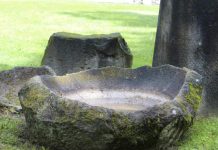Tristan da Cunha is 1,491 miles from the nearest continent and home to just one 300-person village at the foot of an active volcano, and experience life on the inhabited island. This is the world’s most remote island. It is an arduous task to be there, and you have to be mentally and physically fit to journey on this remote island.
It is accessible only by a 6-day boat journey from South Africa or as part of epic month-long cruises through the South Atlantic Ocean, Tristan da Cunha is about as far from a quick holiday destination as it gets. Tristan da Cunha is an archipelago that stands 1,243 miles from Saint Helena, its closest neighbor with residents, 1,491 miles from South Africa, and 2,088 miles from South America.
The majestically beautiful island is just 7 miles long and 37.8 square miles in area, officially known as Edinburgh of the Seven Seas, referred to by locals – less than 300 of them – as The Settlement, located at the foot of the 6,765-foot Queen Mary’s Peak. Although this is small unimposing size and formidable remoteness, “Tristan da Cunha” has a great rich history and a plethora of native wildlife that is truly unique.
Therefore Ocean-wide Expeditions have 4 cruises that take 3 days stopping at Tristan da Cunha, the name given to both the main island and the surrounding archipelago, including the uninhabited Nightingale Islands, and Inaccessible Island and the Gough Islands, which are nature reserves. However, cruises, such as those which leave from Ushuaia in Argentina’s Tierra del Fuego, are the most convenient way to see the island.
Moreover, one of 12 spaces can be filled on the fishing vessel MV Edinburgh and the cargo ship MV Baltic Trader. Though, non-local travelers are at the bottom of an eight-tier priority pecking order that may also include those responding to medical emergencies, official visitors, and locals.
While the other cruise sails annually to Gough Island, run since 2012 by the South African Antarctic Research and Supply Vessel Agulhas II and carries more than forty passengers to and from Tristan. Ocean-wide Expeditions’ Atlantic Odyssey tours, the shortest and cheapest being the 27-night tour from £3,929 calls in on The Settlement, and aims to land on Nightingale and Inaccessible, which millions of millions of seabirds call home.
The landings aren’t guaranteed though, with 30 % of attempts via zodiac boat since 1998 having failed due to bad weather. Thankfully, tours often factor in a spare day. On Nightingale Island, the wandering, Yellow-nosed, and sooty albatrosses all-breed, and the Rockhopper penguins that live on all four of the Tristan Islands are also immensely popular with those who manage to make it there.
Despite of such attractions, tourism is a slight industry for Tristan, with the majority of earnings coming from their commercial crawfish or Tristan rock lobster (Jasus) operations and the sale of their exclusive postage stamps and coins to collectors. Though, a range of accommodation is offered in the form of homestays with locals – descendants of one of seven families originating from Scotland, England, The Netherlands, the United States, and Italy – who also serve as guides and sell crafts and souvenirs.
As expected, all inhabitants are farmers too, and the total area is communally owned. Historically, the island has proven a vital stop for sailing ships needing a stopover in the Atlantic and was annexed by the United Kingdom in 1816 to ensure the French couldn’t use it as a base to attempt a rescue Napoleon Bonaparte, who was imprisoned at Saint Helena.
The Settlement was named in honor of the 1867 visit of Queen Victoria’s son Prince Alfred, the Duke of Edinburgh, when the islands served as a Royal Navy outpost called HMS Atlantic Isle, also said to have been used to observe shipping movements in the ocean and the radio communications of Nazi U-boats. Prince Phillip, the second Duke of Edinburgh, also visited there onboard the royal yacht Britannia in 1957.
Four years later, the whole population was enforced to evacuate to England via Cape Town when Queen Mary’s Peak erupted. Luckily, the damage to the Settlement was found to be minimal and most inhabitants returned in 1963. Moreover, the local penguin population was threatened in March 2011 when the MS Oliva freighter ran aground and created a potentially overwhelming oil slick around Nightingale Island, which has no freshwater.
Rockhoppers had to be taken to Tristan to be cleaned. The remote island then got even more worldwide attention later the same year when Volvo Ocean Race competitor Puma’s Mar Mostro broke a mast during its journey from Alicante to Cape Town and was enforced to stop there. The town turned it on for the eleven-person crew, who visited the local St Mary’s School, took a tour of the fish processing factory, and picked up emergency supplies at the local shop.
Read More – Monsanto Village – Built Between Boulder and Rocks






















